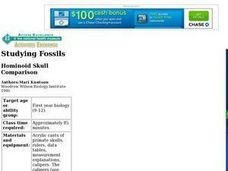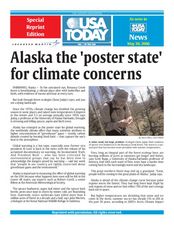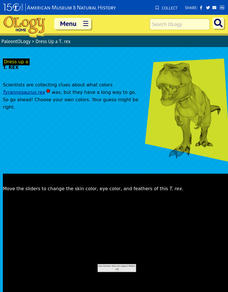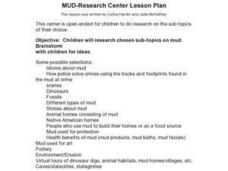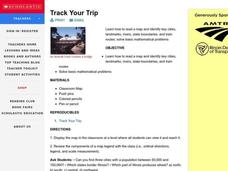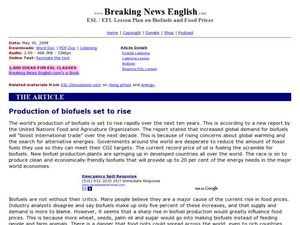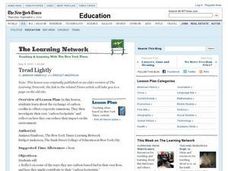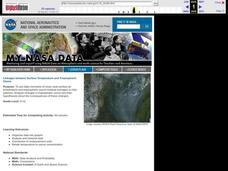Curated OER
Hominoid Skull Comparison
Students are provided with evidence used to support evolutionary theory. They are introduced to classification by using primates as an example. Students read article related to Hominoid Skull Comparison and write a summary about the...
Curated OER
Charles Darwin
For this Charles Darwin worksheet, learners fill in the blank with the correct answer. Students use the suggested text to complete statements about Charles Darwin, his expedition, and his development of his theory of evolution.
Curated OER
Climate Change
Students explore environmental care by researching the impact of human beings on our planet. In this climate change lesson plan, students utilize the Internet to read informational text about climate change and the effect it will have on...
Curated OER
Geology - Merit Badge Workbook
In this geology merit badge worksheet, students answer 5 multiple level questions with information about geology. They complete research to find the answers to questions about geology, fossils, and rock formations. This is a Boy Scout...
Curated OER
Take the One-Tonne Challenge!
Learners explore about the One-Tonne Challenge, and work out how they could reduce their greenhouse gas emissions (GHGs) by one tonne, through individual actions and by influencing other people. Students use a GHG emission table to...
Curated OER
Linkages Between Surface Temperature And Tropospheric Ozone
Students collect and interpret data to make predictions about the levels of ozone in the atmosphere. Using the internet to collect data students use their collected data to create a line graph for analysis. Students make mathematical...
Curated OER
Important, Interesting, and Serious Exercise
For this word usage worksheet, students read the sentences and fill in the gaps with the words important, interesting, and serious to complete the 15 exercises.
Curated OER
Alaska the 'Poster State" For Climate Concerns
Students read an article on Alaska and its climate concerns. In this research lesson students create a poster that contrasts Alaska then and now that pertains to climate change.
American Museum of Natural History
Dress up a T. Rex
Scholars play with an image's color and brightness to predict how tyrannosaurus rex's skin, feathers, and eyes would have appeared. Information and real-world pictures shed light on what evidence guides our assumption of how a...
Curated OER
MUD-Research Center Lesson Plan
Students research chosen sub-topics on mud. They research topics such as idioms about mud, crime solving using tire tracks and animal homes made of mud. Afterward, they choose a presentation method such as a Word document, PowerPoint...
Curated OER
The End of an Era
Students explore the American-Mongolian paleontology expedition of Cretaceous fossil beds at Ukhaa Tolgod in the Gobi Desert. They present information about the life forms, tectonics, climate and geology of this time.
Curated OER
Peak Oil
Students explore the finite petroleum resources available and the surging demand for fossil fuels by developing nations. the need to reduce fossil fuel consumption and the development of alternative, sustainable fuels is examined in this...
Curated OER
Ready, Set, Sum
Third graders summarize a piece of nonfiction text. After reviewing the correct way to read in order to summarize, 3rd graders independently read a nonfiction article. They write a summary paragraph using the three step process outlined...
Curated OER
Simon Says Summarize
Young scholars comprehend text for the purpose of understanding what is being read. In this lesson they practice the skill of summarization with the goal of improving reading comprehension while reading the article "Godzilla".
Curated OER
Good Timing
Students examine sculptures which include animal figures made of different metals. They create their own sculptures of watches to represent a phrase about time.
Curated OER
Track Your Trip
Fourth graders are shown how to read a map and identify key cities, landmarks, rivers, state boundaries, and train routes. They solve basic mathematical problems. Students reivew the componets of a map legend. They are asked to find...
Curated OER
Breaking News English: Production of Biofuels Set to Rise
In this ESL learning exercise, learners read or listen to an article about the production of biofuels. Students complete all or some of the 100 activities available here including discussion, listening, vocabulary and comprehension.
Curated OER
Breaking News English: World Naked Bike Ride Against Oil Use
In this English instructional activity, students read "World Naked Bike Ride Against Oil Use," and then respond to 47 fill in the blank, 7 short answer, 20 matching, and 8 true or false questions about the selection.
Curated OER
The Laughing Leaf
Students demonstrate real-object writing. They discuss a leaf that has human attributes, and using a real leaf write a story about a leaf that tells them a joke, and create an illustration of themselves and their leaf.
Curated OER
Tread Lightly
Students investigate the use of carbon fuels and how they effect the environment. They conduct research using a variety of resources. The information is used from the reading to calculate one's personal influence upon the environment.
Curated OER
Linkages Between Surface Temperature And Tropospheric Ozone
Students organize and analyze data regarding changes in tropospheric ozone and then hypothesize about the consequences of these changes.
Curated OER
Breaking News English: The Year 2007 to be the Hottest Ever
In this English worksheet, students read "The Year 2007 to be the Hottest Ever," and then respond to 47 fill in the blank, 7 short answer, 20 matching, and 8 true or false questions about the selection.
Curated OER
How Much Radiation is Around You?
Learners examine the use, misuse and fear of radiation. They read an article about radiation on food and discuss the positives and negatives of this process. They answer questions to complete the activity.
Curated OER
Make a Dinosaur
Students estimate the size of dinosaurs and create a dinosaur model. They create bar graphs of the sizes of dinosaurs one in meters and the other in "student" units. They draw a pictures and add words or sentences about their dinosaur.
